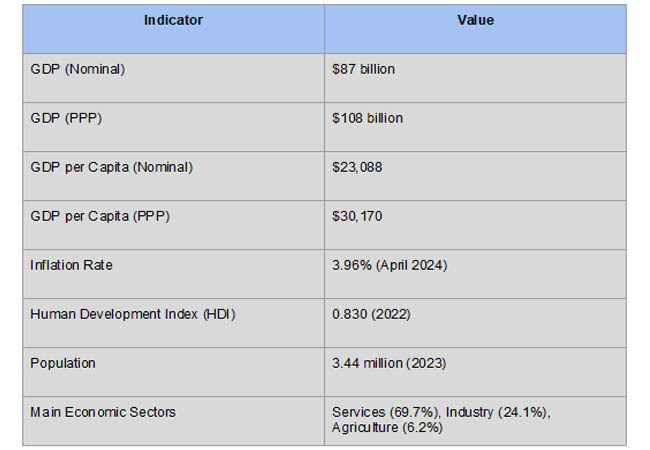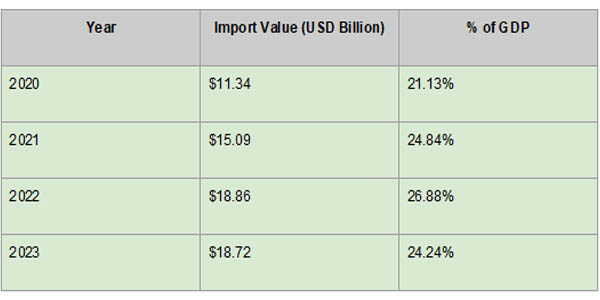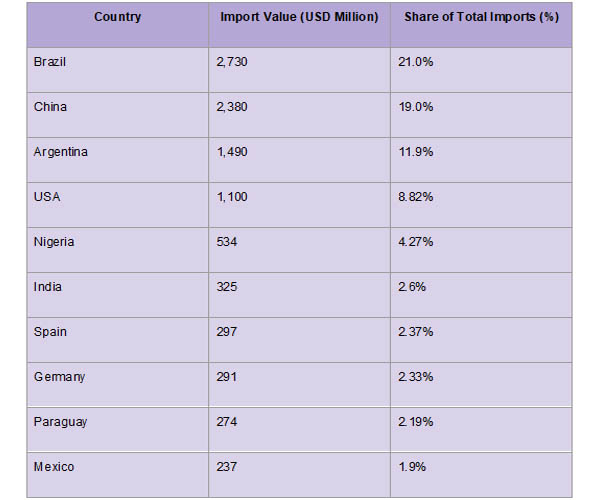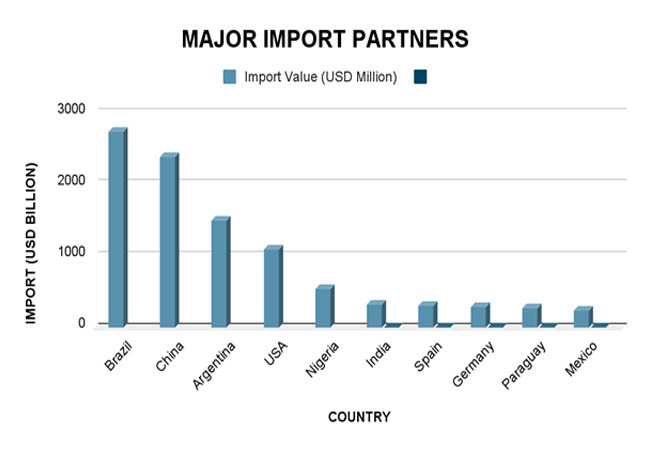
- Jun 26, 2025
Uruguay's Import Landscape: A Thorough Study
Over the past five years, Uruguay, a South American country renowned for its strategic trade policy and steady economy, has seen substantial changes in the dynamics of its imports. With an emphasis on important economic indicators, significant import categories, top trading partners, strategic ramifications, and future projections, this blog explores Uruguay Import Data.
General Economic Indicators of Uruguay

Uruguay has one of the most stable and forward-thinking economies in South America, according to general economic indices. With a nominal GDP of about $87 billion and a GDP per capita of over $23,000, Uruguay is one of the most affluent countries on the continent. According to Import Globals' Uruguay Import Trade Statistics, the nation's economy is primarily service-oriented, with industries like banking, tourism, and telecommunications accounting for around 70% of its GDP. Agro-industry and manufacturing account for about 24% of the GDP, while agriculture, albeit having a lesser GDP share (~6%), is nonetheless vital for exports, especially dairy, cattle, and soy. The government's stable monetary policies have allowed Uruguay to maintain a relatively controlled inflation rate, which was approximately 3.96% in early 2024.
With a Human Development Index (HDI) of 0.830, Uruguay is in the high human development category and stands out socially and developmentally. With 3.4 million residents, it boasts a robust education system, universal healthcare, and a well-established welfare state, all of which help to keep poverty rates low and its literacy rate among the highest in the area. However, according to Import Globals' Uruguay Import Shipment Data, the nation is facing demographic challenges from an aging population, and unemployment is still a problem at about 7.8%. Although it must overcome obstacles including energy reliance, regional volatility, and global market swings to maintain prosperity, Uruguay stands out in Latin America due to its robust economy, solid democratic institutions, and openness to trade and outside investment.
Uruguay's Import Data


Uruguay's import statistics from 2020 to 2024 show a dynamic trade climate influenced by changes in the global economy as well as domestic demand. Uruguay imported commodities totaling around $11.34 billion in 2020, which reflects the COVID-19 pandemic's effects on trade flows. Uruguay's imports increased to $15.09 billion in 2021 and reached a peak of $18.86 billion in 2022, according to Import Globals' Uruguay Import Export Trade Analysis. This indicates a strong demand for consumer products, automobiles, industrial machinery, and mineral fuels. Imports were robust even though 2023 witnessed a tiny decline to $18.72 billion, mostly as a result of local adjustments and worldwide price corrections. The $10.88 billion in imports, according to the partial data (which does not include energy items), demonstrate Uruguay's continued reliance on imported commodities, especially in industries that support manufacturing, energy, and agriculture.
Uruguay's economic progress is reflected in this increase in imports, but it also emphasizes the country's reliance on outside vendors, particularly for energy, machinery, and pharmaceuticals. Over 60% of the nation's overall imports come from major trading partners like the United States, China, Argentina, and Brazil. Product-wise, mineral fuels (HS Code 27) are constantly at the top of the list, followed by automobiles (HS 87), machinery (HS 84), and electrical equipment (HS 85), per Uruguay Export Import Global Trade Data by Import Globals. These trends highlight how crucial imports are to sustaining Uruguay's consumer and industrial markets, but they also highlight weaknesses, including logistical difficulties and price sensitivity to changes in global commodities.
Major Import Product Categories

Uruguay's agricultural foundation, industrial needs, and consumer desires are all reflected in the variety of products it imports. With the biggest share, mineral fuels and oils (HS Code 27) are at the top of the list, underscoring the nation's significant reliance on imported energy sources. Vehicles and automotive parts (HS 87), which are driven by domestic transportation demands and a developing automotive sector, come in second, according to Uruguay Import Export Global Data. Uruguay's industrial and infrastructure development is highlighted by machinery and mechanical appliances (HS 84) and electrical machinery (HS 85), while industries such as manufacturing, healthcare, and agriculture are supported by plastics (HS 39), pharmaceuticals (HS 30), fertilizers (HS 31), and chemical products (HS 38).
Major Import Partners
Due in significant part to physical closeness and shared energy and industrial links, Uruguay's largest supplier, Brazil, accounts for almost 21% of total imports, reflecting both its regional and international trade relationships. China comes in second with about 19%, with a heavy emphasis on manufactured products, electronics, and machinery, according to research by Import Globals on Uruguay Import Data. Almost 12% of imports, including energy and agricultural inputs, come from Argentina, another important neighbor. About 9% of Uruguay's imports come from the US, which is also a major supplier, especially in the areas of machinery, technology, and medicines.


Uruguay's Import Trends and Their Strategic Implications
Uruguay's economic priorities and challenges are reflected in its import patterns:
Energy Dependency: According to an Import Globals Study on Uruguay Export Data, the substantial import of mineral fuels highlights the necessity for energy diversification by indicating reliance on outside energy sources.
Industrial Needs: Continued infrastructural and industrial development initiatives are indicated by high imports of cars and machinery.
Agricultural Inputs: Uruguay's economy depends heavily on agriculture, as evidenced by the imports of animal feed and fertilizers.
Healthcare and Pharmaceuticals: The need for healthcare services and goods is highlighted by the importation of pharmaceuticals.
Forecast Outlook
Projections indicate a steady growth in Uruguay's imports:

Future import trends will be influenced by the following factors:
Global Economic Conditions: Uruguay's import prices and volumes may be impacted by changes in international markets, per a study conducted by Import Globals on Uruguay Import Export Trade Data.
Trade Agreements: New trade agreements have the potential to change or create new import channels.
Domestic Production: Improving domestic production could lessen dependency on specific imports.
Pricing Patterns and Difficulties
Uruguay has several issues with import prices, including:
Currency fluctuations: According to Import Globals' Uruguay Import Custom Data, import expenses may be impacted by changes in exchange rates.
Global Commodity Prices: Import costs are significantly impacted by shifts in global commodity prices, particularly those of raw materials and oil.
Logistics & Supply Chain Disruptions: Events throughout the world have the potential to cause supply chain disruptions, which can raise expenses and cause delays.
In conclusion
Uruguay's import situation between 2020 and 2024 demonstrates how the country strikes a balance between growth and reliance on outside sources. While imports have increased in line with economic growth, issues like energy reliance and changes in international markets still exist, according to Import Globals' Uruguay Import Trade Analysis. For Uruguay to successfully handle the dynamics of imports in the future, strategic planning and diversification are crucial.
If you are looking for detailed and up-to-date Uruguay Export Data, You Can Contact Import Globals.
FAQs
Que: What are the primary imports into Uruguay?
Ams: Mineral fuels, automobiles, machinery, electrical equipment, and medications are Uruguay's main imports.
Que: Who are the main import partners of Uruguay?
Ans: The United States, China, Argentina, and Brazil are the top import partners.
Que: How have imports changed in Uruguay between 2020 and 2024?
Ans: Before a minor decline to $18.72 billion in 2023, imports climbed from $11.34 billion in 2020 to $18.86 billion in 2022. Excluding energy goods, the 2024 amount is $10.88 billion.
Que: What issues influence the cost of imports into Uruguay?
Ans: Changes in global commodity prices, supply chain interruptions, and currency volatility are major obstacles.
Que. Where to obtain detailed Uruguay Importer Data?
Ans. Visit www.importglobals.com or email info@importglobals.com for more information on up-to-date Uruguay Importer Data.
